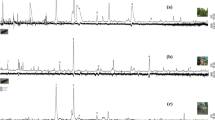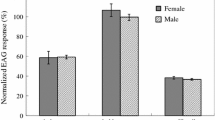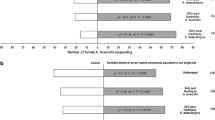Abstract
New Zealand flower thrips, Thrips obscuratus (Thysanoptera: Thripidae), are attracted to ripening fruits, especially peaches. Volatiles from unripe and ripe peach fruits were collected and analyzed by gas chromatography/mass spectrometry. Six lactones were found only in ripe peach volatiles: γ-heptalactone, γ-octalactone, γ-nonalactone, 6-pentyl-2H-pyran-2-one, γ-decalactone, and δ-decalactone. When these compounds were tested individually in field-trapping experiments, three of them (γ-octalactone, γ-nonalactone, and 6-pentyl-2H-pyran-2-one) attracted New Zealand flower thrips. In another field-trapping experiment, aimed at testing various combinations of the three active compounds, no synergistic effects were found among all combinations tested; no combination caught more thrips than 6-pentyl-2H-pyran-2-one, alone. A further field-trapping experiment was conducted to determine the dose (10, 100, and 500 mg) of 6-pentyl-2H-pyran-2-one that gave the greatest catch of T. obscuratus, while also comparing it against another attractant, ethyl nicotinate, for T. obscuratus. The greatest catches in traps baited with either attractant were at loadings of 500 mg. At both 10 and 500 mg, traps baited with 6-pentyl-2H-pyran-2-one caught more T. obscuratus than those baited with the same amounts of ethyl nicotinate. 6-Pentyl-2H-pyran-2-one is a potent attractant for New Zealand flower thrips and, therefore, could be used for monitoring and control of New Zealand flower thrips. Work is underway developing monitoring and control options utilizing 6-pentyl-2H-pyran-2-one for this important pest.




Similar content being viewed by others
References
Chapman GW, Horvat RJ, Forbus WR (1991) Physical and chemical-changes during the maturation of peaches (cv majestic). J Agri Food Chem 39:867–870
Cutler HG (1984) Biologically active natural products from fungi: templates for tomorrow’s pesticides. In bioregulators, chemistry and uses, Ory RL, Rittig FR, (eds) American Chemical Society: Washington, DC, pp. 153–170
El-sayed AM (2013) The Pherobase: Database of Insect Pheromones and Semiochemicals. http://www.pherobase.com
El-sayed AM, Suckling DM, Byers JA, Jang EB, Wearing CH (2009a) Potential of lure and kill for long-term pest management and eradication of invasive species. J Econ Entomol 102:815–835
El-sayed AM, Mitchell VJ, Mclaren GF, Manning LM, Bunn B, Suckling DM (2009b) Attraction of New Zealand flower thrips, Thrips obscuratus, to cis-jasmone, a volatile identified from Japanese honeysuckle flowers. J Chem Ecol 35:656–663
El-sayed AM, Suckling DM, Wearing CH, Byers JA (2006) Potential of mass trapping for long-term pest management and eradication of invasive species. J Econ Entomol 99:1550–1564
Fermaud M, Gaunt RE, Elmer PAG (1994) The influence of Thrips obscuratus on infection and contamination of kiwifruit by Botrytis cinerea. Plant Pathol 43:953–960
Horvat RJ, Chapman GW (1990) Comparison of volatile compounds from peach fruit and leaves (cv monroe) during maturation. J Agri Food Chem 38:1442–1444
Horvat RJ, Chapman GW, Robertson JA, Meredith FI, Scorza R, Callahan AM, Morgens P (1990) Comparison of the volatile compounds from several commercial peach cultivars. J Agr Food Chem 38:234–237
Janssen E, Hölldobler B, Kern F, Bestmann HJ, Tsuji K (1997) Trail pheromone of Myrmicine ant Pristomyrmex pungens. J Chem Ecol 23:1025–1034
Lavilla T, Recasens I, Lopez ML, Puy J (2002) Multivariate analysis of maturity stages, including quality and aroma, in ‘Royal Glory’ peaches and ‘Big Top’ nectarines. J Sci Food and Agri 82:1842–1849
Kakiuchi N, Ohmiya A (1991) Changes in the composition and content of volatile constituents in peach fruits in relation to maturity at harvest and artificial ripening. J Jap Soc Hort Sci 60:209–216
Kirk WDJ (1985) Effect of some floral scents on host findings by thrips (Insecta: Thysanoptera). J Chem Ecol 11:35–43
Mclaren GF (1992) Thrips on nectarines in the spring. Proceedings 45th NZ Plant Protection Conference: 111–115
Mclaren GF (1995) Factors influencing the monitoring of New Zealand flower thrips Thrips obscuratus (Crawford). Proc Australia and New Zealand Thrips workshop: Methods Biology, Ecology and Management 25–27 July 1995, Gosford, Australia: 52–62
Mclaren GF, Fraser JA (2000) Development of thresholds for insecticidal control of New Zealand flower thrips on nectarines in spring. NZ Plant Protection 53:194–199
Mclaren GF and Fraser JA (2002) Diurnal activity of New Zealand flower thrips on stonefruit in spring and at harvest. Proceedings of the 7th International Symposium on Thysanoptera, pp. 269–271
Mound LA (2005) Thysanoptera: diversity and interactions. Annu Rev Entomol 50:247–269
Murai T, Imai T, Maekawa M (2000) Methyl anthranilate as an attractant for two thrips species and the thrips parasitoid Ceranisus menes. J Chem Ecol 26:2557–2565
Norton SA (1984) Thrips pollination in the lowland forest of New Zealand. NZ J Ecol 7:157–164
Parker SR, Cutler HG, Jacyno JM, Hill RA (1997) Biological activity of 6-pentyl-2H-pyran-2-one and its analogs. J Agric Food Chem 45:2774–2776
Penman DR, Osborne GO, Worner RB, Chapman RB, Mclaren GF (1982) Ethyl nicotinate: A chemical attractant for Thrips obscuratus (Thysanoptera: Thripidae) in stonefruit in New Zealand. J Chem Ecol 8:1299–1303
Sas Institute Inc (1998) Statview. SAS Institute Inc., Cary, North Carolina
Suckling DM, Shaw PW (1992) Conditions that favor mating disruption of Epiphyas postvittana (Lepidoptera: Tortricidae). Env Ent 21:949–956
Teulon DAJ, Hollister B, Butler RC, Cameron EA (1999) Colour and odour responses of flying western flower thrips: wind tunnel and greenhouse experiments. Entomol Exp Appl 93:9–19
Teulon DAJ, Penman DR (1990) Host records for the New Zealand flower thrips (Thrips obscuratus (Crawford) Thysanoptera: Thripidae). NZ Entomologist 13:46–51
Teulon DAJ, Penman DR, Ramakers PMJ (1993) Volatile chemicals for thrips (Thysanoptera: Thripidae) Host finding and applications for thrips pest management. J Econ Entomol 86:1405–1415
Tian R, Izumi Y, Sonoda S, Yoshida H, Takanashi T, Nakamuta K, Tsumuki H (2008) Electroantennographic responses and field attraction to peach fruit odors in the fruit-piercing moth, Oraesia excavata (Butler) (Lepidoptera: Noctuidae). Appl Entomol Zool 43:265–269
Visai C, Vanoli M (1997) Volatile compound production during growth and ripening of peaches and nectarines. Sci Hortic 70:15–24
Acknowledgments
This work was supported by the New Zealand Foundation for Research Science and Technology (CO6X0811, Integrated Pest Management in Horticulture) and Summerfruit New Zealand. We thank John Revell for helping with chemical analysis and Table 1. We thank Mr. Bruce Tweedy for allowing us to conduct experiments in his orchard.
Author information
Authors and Affiliations
Corresponding author
Rights and permissions
About this article
Cite this article
El-Sayed, A.M., Mitchell, V.J. & Suckling, D.M. 6-Pentyl-2H-pyran-2-one: A Potent Peach-Derived Kairomone for New Zealand Flower Thrips, Thrips obscuratus . J Chem Ecol 40, 50–55 (2014). https://doi.org/10.1007/s10886-014-0379-3
Received:
Revised:
Accepted:
Published:
Issue Date:
DOI: https://doi.org/10.1007/s10886-014-0379-3




